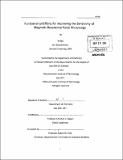Fundamental efforts for improving the sensitivity of magnetic resonance force microscopy
Author(s)
Tao, Ye, Ph. D. Massachusetts Institute of Technology
DownloadFull printable version (6.765Mb)
Other Contributors
Massachusetts Institute of Technology. Dept. of Chemistry.
Advisor
Christian L. Degen.
Terms of use
Metadata
Show full item recordAbstract
Introduction: Complete understanding of the mechanisms of biological processes, indispensable for the rational design and testing of therapeutic strategies, can be greatly facilitated by easy and rapid access to macromolecular structures at the atomic resolution. As of 2011, a general method for rapid rendering of macromolecular and cellular structures with atomic resolution represents both a major challenge and a major need in science. Such a method would prove all the more valuable to understanding the conformational complexities of protein misfolding diseases and amyloid formation phenomena , caused by complex networks of structural transition reactions linking the monomeric, oligomeric, and polymorphic fibrillar forms of disease-causing proteins, the structures of which have only been rigorously characterized in a small number of cases. To date, the majority of protein and RNA structures known have been solved by either X-ray crystallography or by NMR spectroscopy. Many requirements on the sample prevent these methods from being generally applicable to biological specimens. First, since X-ray crystallography and NMR spectroscopy are techniques based on assessing the average properties of a macroscopic sample, a high degree of sample heterogeneity undermines their ability to solve structures. Second, X-ray crystallography requires the sample protein to form ordered crystals. However, the procedure for crystallizing proteins remains a daunting trial-and-error process and important proteins like membrane proteins are impossible to crystallize in their native forms. Recent advances in solid state NMR (ssNMR) spectroscopy have made it possible to study membrane proteins, but the technique is still limited by protein size and by the need for order, at least at the local level. For these reasons, the structural studies of macromolecule that contain high degrees of conformational heterogeneity and that are large in size have remained challenging, rare, and largely tackled, with difficulty, by computational approaches.
Description
Thesis (S.M.)--Massachusetts Institute of Technology, Dept. of Chemistry, 2011. "July 2011." Cataloged from PDF version of thesis. Includes bibliographical references (p. 20-24).
Date issued
2011Department
Massachusetts Institute of Technology. Department of ChemistryPublisher
Massachusetts Institute of Technology
Keywords
Chemistry.